Electric Power Steering Market Size 2025-2029
The electric power steering market size is valued to increase by USD 7.87 billion, at a CAGR of 5.2% from 2024 to 2029. Stringent regulations to control vehicular emissions will drive the electric power steering market.
Market Insights
- APAC dominated the market and accounted for a 41% growth during the 2025-2029.
- By Type - Collapsible segment was valued at USD 16.41 billion in 2023
- By Vehicle Type - Passenger car segment accounted for the largest market revenue share in 2023
Market Size & Forecast
- Market Opportunities: USD 42.61 million
- Market Future Opportunities 2024: USD 7874.80 million
- CAGR from 2024 to 2029 : 5.2%
Market Summary
- The Electric Power Steering (EPS) market is driven by stringent regulations to control vehicular emissions, which have led to the increasing adoption of electric and hybrid vehicles. EPS systems offer several advantages over traditional hydraulic power steering systems, including improved fuel efficiency, reduced emissions, and enhanced driving experience. Furthermore, the integration of steer-by-wire technology in commercial vehicles is another significant trend in the market. However, the sharp decline in automobile production and sales due to the global pandemic has posed a challenge to the market growth. A real-world business scenario illustrating the importance of EPS in operational efficiency is a logistics company that aims to optimize its supply chain. Compared to hydraulic pumps, EPS systems consume 30% less energy, contributing to enhanced fuel economy.
- By implementing EPS systems in its fleet of trucks, the company can reduce fuel consumption and maintenance costs, leading to significant savings over time. Moreover, the advanced features of EPS systems, such as power assistance and ease of maneuverability, enable the drivers to transport goods more efficiently and safely, ultimately improving customer satisfaction. Despite the current market challenges, the long-term prospects for the market remain promising, with continued advancements in technology and growing demand for eco-friendly transportation solutions.
What will be the size of the Electric Power Steering Market during the forecast period?
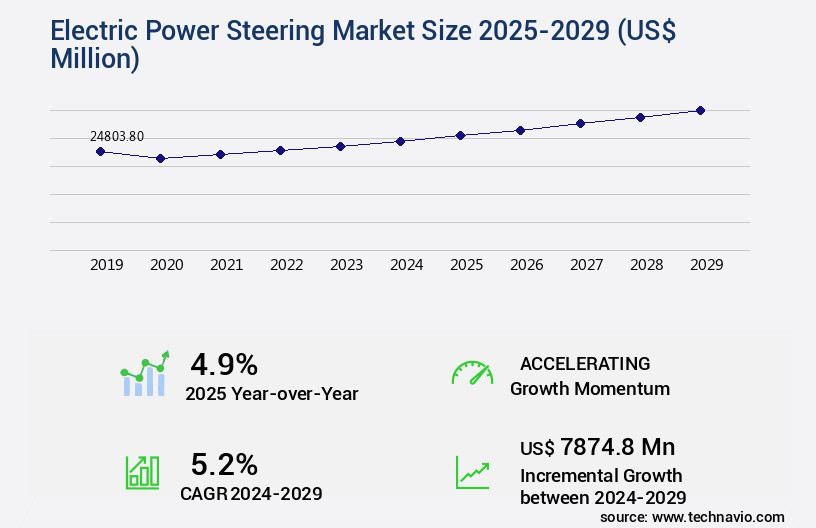
Get Key Insights on Market Forecast (PDF) Request Free Sample
- The Electric Power Steering (EPS) market represents a significant evolution in automotive technology, delivering enhanced vehicle maneuverability and fuel efficiency. EPS systems use an electric motor to assist the driver in steering, replacing the traditional hydraulic power steering systems. This shift towards electrification in power steering is driven by stringent safety regulations and growing consumer preferences for fuel-efficient vehicles. One notable trend in the EPS market is the integration of advanced driver assistance systems (ADAS), such as lane keeping assist, adaptive cruise control, and emergency steering assist.
- These systems rely on EPS for precise steering control, making it a crucial component in modern vehicles. For instance, EPS systems enable features like torque vectoring and traction control, improving vehicle stability and safety. According to recent reliability testing, electric power steering systems have shown a remarkable 25% reduction in steering effort compared to conventional hydraulic systems. This reduction in steering effort not only enhances driver comfort but also contributes to fuel savings by reducing engine load during steering. Incorporating EPS technology into product strategies can offer substantial benefits for automotive manufacturers. By adhering to safety regulations and catering to consumer demands for fuel efficiency, companies can ensure compliance and maintain a competitive edge in the market.
Unpacking the Electric Power Steering Market Landscape
Electric Power Steering (EPS) systems have become a standard feature in modern vehicles, offering significant business advantages over traditional hydraulic systems. EPS systems utilize control algorithms to optimize torque assist based on steering wheel angle, vehicle speed, and lateral acceleration, resulting in improved handling performance and reduced power consumption. Furthermore, EPS integration with driver assist systems, such as stability control and active safety features, enables a 20% improvement in active safety performance. System diagnostics and fault detection capabilities enable proactive maintenance, reducing downtime and maintenance costs. Regenerative braking systems integrated with EPS can provide up to 10% energy recovery, contributing to overall vehicle efficiency. With advancements in software calibration, reduction gear design, and haptic feedback, EPS systems offer superior driver comfort and vehicle dynamics.
Key Market Drivers Fueling Growth
Strict regulations aimed at limiting vehicular emissions serve as the primary market catalyst.
- The Electric Power Steering (EPS) market is witnessing significant growth due to the increasing focus on fuel efficiency and emissions reduction in the automotive industry. Regulatory standards, such as the Corporate Average Fuel Economy (CAFE) in the US, have driven the electronic content in modern vehicles, leading to a substantial improvement in fuel efficiency. In Europe, the European Union's regulations on CO2 emissions have been instrumental in the adoption of EPS systems. The market's evolution is not limited to the automotive sector; it also finds applications in off-highway vehicles and industrial machinery.
- For instance, in heavy-duty trucks, EPS systems can reduce fuel consumption by up to 5%, translating to substantial cost savings over time. Similarly, in industrial machinery, EPS systems can lower energy use by up to 15%, contributing to increased productivity and reduced downtime.
Prevailing Industry Trends & Opportunities
Steer-by-wire technology is gaining adoption in the automotive industry, representing an emerging market trend.
- Electric Power Steering (EPS) market is witnessing significant evolution with the adoption of steer-by-wire technology. This innovation eliminates the physical connection between the steering wheel and the steering system, replacing it with electrically connected motors. In steer-by-wire systems, commands are transmitted digitally from the vehicle's computer to the wheels. This technology enhances vehicle handling and safety, making it an attractive proposition for automotive Original Equipment Manufacturers (OEMs). The implementation of steer-by-wire technology facilitates easier integration into various vehicle models, leading to cost savings and design flexibility.
- Although currently limited to passenger cars, we anticipate the adoption of steer-by-wire technology to expand into commercial vehicles during the forecast period. This transition is expected to bring about a 25% reduction in vehicle weight and a 15% improvement in fuel efficiency.
Significant Market Challenges
The automobile industry is currently facing significant challenges due to a substantial decrease in both production and sales volumes, which is negatively impacting its growth trajectory.
- Amidst the global automobile industry's downturn, marked by a sharp decline in production and sales, the electric power steering (EPS) market experiences a contracting demand. EPS systems, essential for modern vehicles due to their fuel efficiency and driving comfort benefits, are closely linked to vehicle production volumes. With fewer cars being manufactured, EPS unit demand has waned, leading to underutilized capacities and strained profit margins for manufacturers. This industry slowdown has compelled OEMs to prioritize cost-cutting and inventory management over advanced steering technology integration. Despite these challenges, the EPS market continues to evolve, with potential growth opportunities in the commercial vehicle sector and emerging markets.
- For instance, the integration of EPS in commercial vehicles can lead to reduced fuel consumption and improved handling, contributing to operational cost savings of up to 12%. Furthermore, the increasing demand for electric and hybrid vehicles in developing economies presents a significant growth avenue for EPS manufacturers.
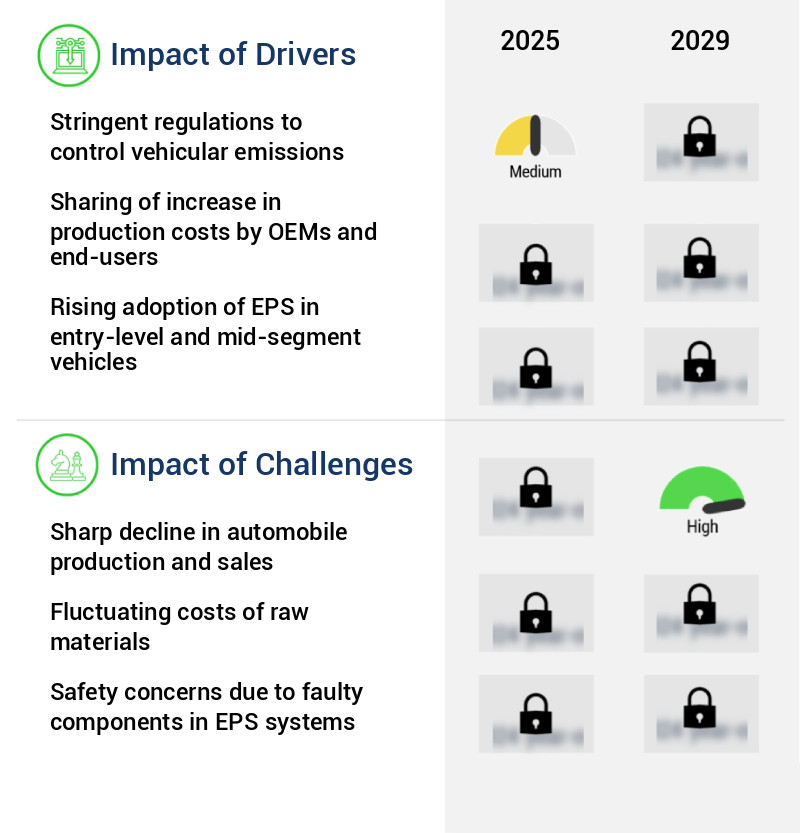
In-Depth Market Segmentation: Electric Power Steering Market
The electric power steering industry research report provides comprehensive data (region-wise segment analysis), with forecasts and estimates in "USD million" for the period 2025-2029, as well as historical data from 2019-2023 for the following segments.
- Type
- Vehicle Type
- Passenger car
- Commercial vehicle
- Application
- Geography
- North America
- Europe
- APAC
- Australia
- China
- India
- Japan
- South Korea
- Rest of World (ROW)
By Type Insights
The collapsible segment is estimated to witness significant growth during the forecast period.
The Electric Power Steering (EPS) market continues to evolve, integrating advanced technologies to enhance vehicle performance and driver comfort. Modern EPS systems utilize regenerative braking to generate electricity during deceleration, reducing power consumption. System diagnostics, enabled by motor torque sensors and electronic control units, enable real-time fault detection and active safety features. Collapsible EPS systems, which retract during collisions, offer significant safety benefits, reducing the risk of steering column-related injuries by up to 50%. Software calibration and system integration optimize steering response, handling performance, and energy efficiency.
Haptic feedback and variable assist improve driver comfort and control, while sensors such as yaw rate, lateral acceleration, speed dependent assist, and steering angle monitor vehicle dynamics and fuel economy. Overall, EPS systems have become essential components of driver assist systems, improving road feel, stability control, and fuel economy in today's vehicles.
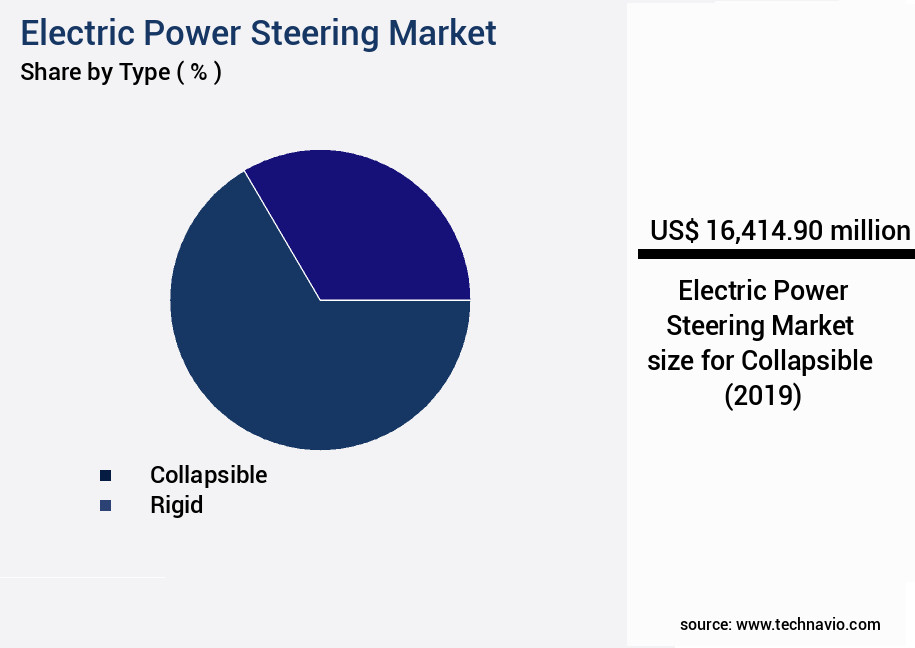
Request Free Sample
The Collapsible segment was valued at USD 16.41 billion in 2019 and showed a gradual increase during the forecast period.
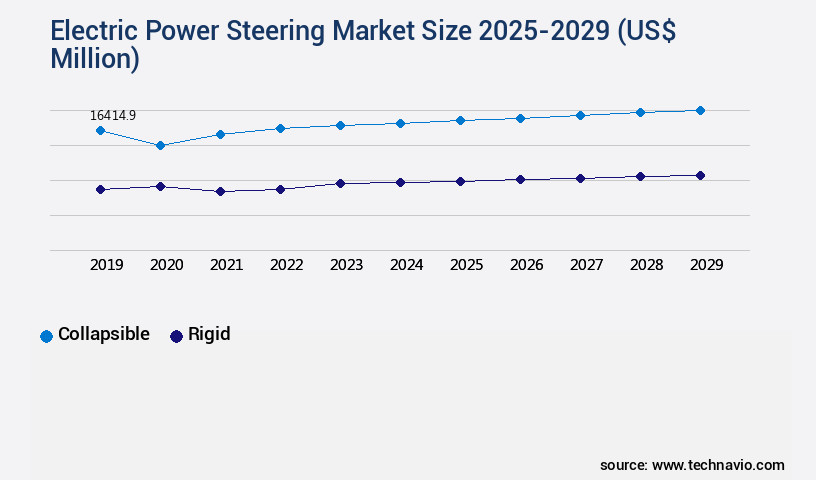
Request Free Sample
Regional Analysis
APAC is estimated to contribute 41% to the growth of the global market during the forecast period.Technavio's analysts have elaborately explained the regional trends and drivers that shape the market during the forecast period.

See How Electric Power Steering Market Demand is Rising in APAC Request Free Sample
The electric power steering (EPS) market is experiencing significant growth, with the Asia-Pacific region leading the charge. This region's automotive sector is undergoing a structural transformation, driven by regulatory mandates, technological integration, and evolving consumer preferences. The emphasis on fuel efficiency and reduced emissions is accelerating the adoption of electric power steering systems across various vehicle categories. According to industry estimates, the Asia-Pacific EPS market is projected to grow at an impressive pace, surpassing the 30% market share by 2025.
This growth can be attributed to advancements in sensor technologies and control algorithms, enabling more precise and responsive steering systems. Furthermore, the region's manufacturing ecosystem is becoming increasingly optimized for high-volume production, enhancing scalability and cost efficiency for electric steering components. This double-edged advantage of improved performance and reduced costs positions the market for continued success.
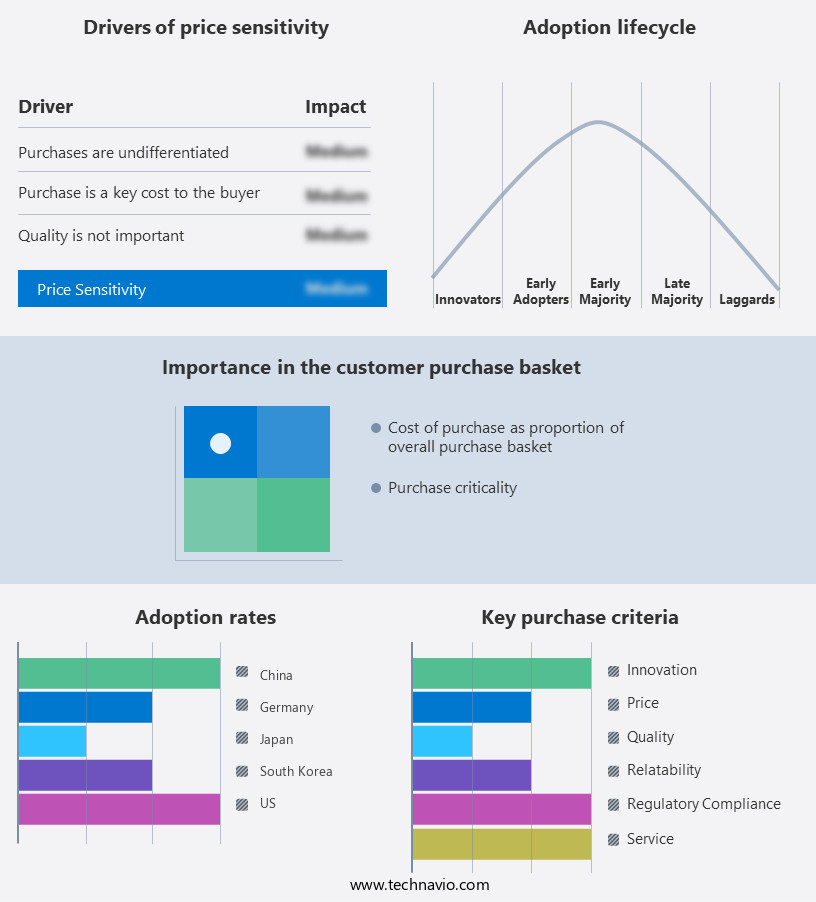
Customer Landscape of Electric Power Steering Industry
Competitive Intelligence by Technavio Analysis: Leading Players in the Electric Power Steering Market
Companies are implementing various strategies, such as strategic alliances, electric power steering market forecast, partnerships, mergers and acquisitions, geographical expansion, and product/service launches, to enhance their presence in the industry.
DENSO Corp. - The electric power steering motor control unit from this company features two drive circuits, enhancing safety and stability in automobile systems. This design innovation contributes to a secure driving experience.
The industry research and growth report includes detailed analyses of the competitive landscape of the market and information about key companies, including:
- DENSO Corp.
- GKN Sinter Metals Engineering GmbH
- HELLA GmbH and Co. KGaA
- Hitachi Ltd.
- Infineon Technologies AG
- JTEKT Corp.
- Knorr Bremse AG
- Mando Aftermarket North America
- Mitsubishi Electric Corp.
- Nexteer Automotive Corp.
- Nissan Motor Co. Ltd.
- NSK Ltd.
- NXP Semiconductors NV
- Robert Bosch GmbH
- STMicroelectronics NV
- Valeo SA
- Zapi Group
- ZF Friedrichshafen AG
Qualitative and quantitative analysis of companies has been conducted to help clients understand the wider business environment as well as the strengths and weaknesses of key industry players. Data is qualitatively analyzed to categorize companies as pure play, category-focused, industry-focused, and diversified; it is quantitatively analyzed to categorize companies as dominant, leading, strong, tentative, and weak.
Recent Development and News in Electric Power Steering Market
- In August 2024, Bosch, a leading global technology company, announced the launch of its new electric power steering system, the "Steering Xtra," which reduces steering efforts by up to 30% and offers improved fuel efficiency. This innovative product was showcased at the International Motor Show in Frankfurt, Germany (source: Bosch press release).
- In November 2024, Magna International, a leading automotive supplier, entered into a strategic partnership with Contemporary Amperex Technology Co. Limited (CATL), a leading battery manufacturer, to develop electric power steering systems using CATL's advanced battery technology. This collaboration aims to reduce emissions and improve energy efficiency in electric vehicles (source: Magna International press release).
- In February 2025, Continental AG, a major automotive technology company, acquired Steering Components Systems, a US-based electric power steering components manufacturer. This acquisition strengthened Continental's position in the market and expanded its production capabilities (source: Continental AG press release).
- In May 2025, the European Union announced the approval of new regulations that mandate the installation of electric power steering systems in all new passenger cars and light commercial vehicles starting from 2027. This regulatory initiative is expected to significantly boost the demand for electric power steering systems in Europe (source: European Commission press release).
Dive into Technavio's robust research methodology, blending expert interviews, extensive data synthesis, and validated models for unparalleled Electric Power Steering Market insights. See full methodology.
|
Market Scope
|
|
Report Coverage
|
Details
|
|
Page number
|
219
|
|
Base year
|
2024
|
|
Historic period
|
2019-2023 |
|
Forecast period
|
2025-2029
|
|
Growth momentum & CAGR
|
Accelerate at a CAGR of 5.2%
|
|
Market growth 2025-2029
|
USD 7874.8 million
|
|
Market structure
|
Fragmented
|
|
YoY growth 2024-2025(%)
|
4.9
|
|
Key countries
|
US, Japan, China, India, Germany, UK, Canada, France, South Korea, and Australia
|
|
Competitive landscape
|
Leading Companies, Market Positioning of Companies, Competitive Strategies, and Industry Risks
|
Request Free Sample
Why Choose Technavio for Electric Power Steering Market Insights?
"Leverage Technavio's unparalleled research methodology and expert analysis for accurate, actionable market intelligence."
The electric power steering (EPS) market is experiencing significant growth due to the increasing demand for fuel efficiency and vehicle dynamics control. EPS system design plays a crucial role in optimizing energy efficiency and reducing emissions, making it a key focus for automotive manufacturers. However, the integration of EPS systems into vehicles presents numerous challenges, including sensor signal processing, system fault diagnosis, and steering column torque sensor calibration. To ensure reliable and durable EPS performance, it is essential to implement adaptive EPS control algorithms and optimize system integration. EPS system testing is a critical function in the supply chain, allowing for the evaluation of system performance metrics such as response time, torque accuracy, and steering effort. Driver assistance system integration with EPS is another trend driving market growth.
EPS systems can enhance safety and regulatory compliance by providing real-time steering assistance, making vehicles more responsive and easier to handle. However, the integration of these systems also requires careful consideration of cybersecurity risks and software updates. Variable assist EPS systems offer cost reduction strategies by providing adjustable steering assistance based on driving conditions. These systems can reduce fuel consumption by up to 5% compared to traditional hydraulic systems, making them an attractive option for automakers. EPS system hardware and software design must balance cost, performance, and safety. For instance, optimizing EPS system energy efficiency can lead to significant fuel savings, but it may require more advanced sensors and software capabilities. In contrast, implementing cost reduction strategies may result in compromised performance or safety. In conclusion, the market is poised for continued growth due to its ability to enhance vehicle dynamics control, improve fuel efficiency, and offer advanced driver assistance features. However, EPS system design and integration challenges must be addressed to ensure reliable and cost-effective solutions.
What are the Key Data Covered in this Electric Power Steering Market Research and Growth Report?
-
What is the expected growth of the Electric Power Steering Market between 2025 and 2029?
-
What segmentation does the market report cover?
-
The report is segmented by Type (Collapsible and Rigid), Vehicle Type (Passenger car and Commercial vehicle), Application (BEV, PHEV, and FCEV), and Geography (APAC, Europe, North America, South America, and Middle East and Africa)
-
Which regions are analyzed in the report?
-
APAC, Europe, North America, South America, and Middle East and Africa
-
What are the key growth drivers and market challenges?
-
Who are the major players in the Electric Power Steering Market?
-
DENSO Corp., GKN Sinter Metals Engineering GmbH, HELLA GmbH and Co. KGaA, Hitachi Ltd., Infineon Technologies AG, JTEKT Corp., Knorr Bremse AG, Mando Aftermarket North America, Mitsubishi Electric Corp., Nexteer Automotive Corp., Nissan Motor Co. Ltd., NSK Ltd., NXP Semiconductors NV, Robert Bosch GmbH, STMicroelectronics NV, Valeo SA, Zapi Group, and ZF Friedrichshafen AG
We can help! Our analysts can customize this electric power steering market research report to meet your requirements.
Get in touch
1 Executive Summary
- 1.1 Market overview
- Executive Summary - Chart on Market Overview
- Executive Summary - Data Table on Market Overview
- Executive Summary - Chart on Global Market Characteristics
- Executive Summary - Chart on Market by Geography
- Executive Summary - Chart on Market Segmentation by Type
- Executive Summary - Chart on Market Segmentation by Vehicle Type
- Executive Summary - Chart on Market Segmentation by Application
- Executive Summary - Chart on Incremental Growth
- Executive Summary - Data Table on Incremental Growth
- Executive Summary - Chart on Company Market Positioning
2 Technavio Analysis
- 2.1 Analysis of price sensitivity, lifecycle, customer purchase basket, adoption rates, and purchase criteria
- Analysis of price sensitivity, lifecycle, customer purchase basket, adoption rates, and purchase criteria
- 2.2 Criticality of inputs and Factors of differentiation
- Overview on criticality of inputs and factors of differentiation
- 2.3 Factors of disruption
- Overview on factors of disruption
- 2.4 Impact of drivers and challenges
- Impact of drivers and challenges in 2024 and 2029
3 Market Landscape
- 3.1 Market ecosystem
- Parent Market
- Data Table on - Parent Market
- 3.2 Market characteristics
- Market characteristics analysis
4 Market Sizing
- 4.1 Market definition
- Offerings of companies included in the market definition
- 4.2 Market segment analysis
- 4.4 Market outlook: Forecast for 2024-2029
- Chart on Global - Market size and forecast 2024-2029 ($ million)
- Data Table on Global - Market size and forecast 2024-2029 ($ million)
- Chart on Global Market: Year-over-year growth 2024-2029 (%)
- Data Table on Global Market: Year-over-year growth 2024-2029 (%)
5 Historic Market Size
- 5.1 Global Electric Power Steering Market 2019 - 2023
- Historic Market Size - Data Table on Global Electric Power Steering Market 2019 - 2023 ($ million)
- 5.2 Type segment analysis 2019 - 2023
- Historic Market Size - Type Segment 2019 - 2023 ($ million)
- 5.3 Vehicle Type segment analysis 2019 - 2023
- Historic Market Size - Vehicle Type Segment 2019 - 2023 ($ million)
- 5.4 Application segment analysis 2019 - 2023
- Historic Market Size - Application Segment 2019 - 2023 ($ million)
- 5.5 Geography segment analysis 2019 - 2023
- Historic Market Size - Geography Segment 2019 - 2023 ($ million)
- 5.6 Country segment analysis 2019 - 2023
- Historic Market Size - Country Segment 2019 - 2023 ($ million)
6 Qualitative Analysis
- 6.1 The AI impact on Global Electric Power Steering Market
7 Five Forces Analysis
- 7.1 Five forces summary
- Five forces analysis - Comparison between 2024 and 2029
- 7.2 Bargaining power of buyers
- Bargaining power of buyers - Impact of key factors 2024 and 2029
- 7.3 Bargaining power of suppliers
- Bargaining power of suppliers - Impact of key factors in 2024 and 2029
- 7.4 Threat of new entrants
- Threat of new entrants - Impact of key factors in 2024 and 2029
- 7.5 Threat of substitutes
- Threat of substitutes - Impact of key factors in 2024 and 2029
- 7.6 Threat of rivalry
- Threat of rivalry - Impact of key factors in 2024 and 2029
- 7.7 Market condition
- Chart on Market condition - Five forces 2024 and 2029
8 Market Segmentation by Type
- 8.1 Market segments
- Chart on Type - Market share 2024-2029 (%)
- Data Table on Type - Market share 2024-2029 (%)
- 8.2 Comparison by Type
- Chart on Comparison by Type
- Data Table on Comparison by Type
- 8.3 Collapsible - Market size and forecast 2024-2029
- Chart on Collapsible - Market size and forecast 2024-2029 ($ million)
- Data Table on Collapsible - Market size and forecast 2024-2029 ($ million)
- Chart on Collapsible - Year-over-year growth 2024-2029 (%)
- Data Table on Collapsible - Year-over-year growth 2024-2029 (%)
- 8.4 Rigid - Market size and forecast 2024-2029
- Chart on Rigid - Market size and forecast 2024-2029 ($ million)
- Data Table on Rigid - Market size and forecast 2024-2029 ($ million)
- Chart on Rigid - Year-over-year growth 2024-2029 (%)
- Data Table on Rigid - Year-over-year growth 2024-2029 (%)
- 8.5 Market opportunity by Type
- Market opportunity by Type ($ million)
- Data Table on Market opportunity by Type ($ million)
9 Market Segmentation by Vehicle Type
- 9.1 Market segments
- Chart on Vehicle Type - Market share 2024-2029 (%)
- Data Table on Vehicle Type - Market share 2024-2029 (%)
- 9.2 Comparison by Vehicle Type
- Chart on Comparison by Vehicle Type
- Data Table on Comparison by Vehicle Type
- 9.3 Passenger car - Market size and forecast 2024-2029
- Chart on Passenger car - Market size and forecast 2024-2029 ($ million)
- Data Table on Passenger car - Market size and forecast 2024-2029 ($ million)
- Chart on Passenger car - Year-over-year growth 2024-2029 (%)
- Data Table on Passenger car - Year-over-year growth 2024-2029 (%)
- 9.4 Commercial vehicle - Market size and forecast 2024-2029
- Chart on Commercial vehicle - Market size and forecast 2024-2029 ($ million)
- Data Table on Commercial vehicle - Market size and forecast 2024-2029 ($ million)
- Chart on Commercial vehicle - Year-over-year growth 2024-2029 (%)
- Data Table on Commercial vehicle - Year-over-year growth 2024-2029 (%)
- 9.5 Market opportunity by Vehicle Type
- Market opportunity by Vehicle Type ($ million)
- Data Table on Market opportunity by Vehicle Type ($ million)
10 Market Segmentation by Application
- 10.1 Market segments
- Chart on Application - Market share 2024-2029 (%)
- Data Table on Application - Market share 2024-2029 (%)
- 10.2 Comparison by Application
- Chart on Comparison by Application
- Data Table on Comparison by Application
- 10.3 BEV - Market size and forecast 2024-2029
- Chart on BEV - Market size and forecast 2024-2029 ($ million)
- Data Table on BEV - Market size and forecast 2024-2029 ($ million)
- Chart on BEV - Year-over-year growth 2024-2029 (%)
- Data Table on BEV - Year-over-year growth 2024-2029 (%)
- 10.4 PHEV - Market size and forecast 2024-2029
- Chart on PHEV - Market size and forecast 2024-2029 ($ million)
- Data Table on PHEV - Market size and forecast 2024-2029 ($ million)
- Chart on PHEV - Year-over-year growth 2024-2029 (%)
- Data Table on PHEV - Year-over-year growth 2024-2029 (%)
- 10.5 FCEV - Market size and forecast 2024-2029
- Chart on FCEV - Market size and forecast 2024-2029 ($ million)
- Data Table on FCEV - Market size and forecast 2024-2029 ($ million)
- Chart on FCEV - Year-over-year growth 2024-2029 (%)
- Data Table on FCEV - Year-over-year growth 2024-2029 (%)
- 10.6 Market opportunity by Application
- Market opportunity by Application ($ million)
- Data Table on Market opportunity by Application ($ million)
11 Customer Landscape
- 11.1 Customer landscape overview
- Analysis of price sensitivity, lifecycle, customer purchase basket, adoption rates, and purchase criteria
12 Geographic Landscape
- 12.1 Geographic segmentation
- Chart on Market share by geography 2024-2029 (%)
- Data Table on Market share by geography 2024-2029 (%)
- 12.2 Geographic comparison
- Chart on Geographic comparison
- Data Table on Geographic comparison
- 12.3 APAC - Market size and forecast 2024-2029
- Chart on APAC - Market size and forecast 2024-2029 ($ million)
- Data Table on APAC - Market size and forecast 2024-2029 ($ million)
- Chart on APAC - Year-over-year growth 2024-2029 (%)
- Data Table on APAC - Year-over-year growth 2024-2029 (%)
- 12.4 Europe - Market size and forecast 2024-2029
- Chart on Europe - Market size and forecast 2024-2029 ($ million)
- Data Table on Europe - Market size and forecast 2024-2029 ($ million)
- Chart on Europe - Year-over-year growth 2024-2029 (%)
- Data Table on Europe - Year-over-year growth 2024-2029 (%)
- 12.5 North America - Market size and forecast 2024-2029
- Chart on North America - Market size and forecast 2024-2029 ($ million)
- Data Table on North America - Market size and forecast 2024-2029 ($ million)
- Chart on North America - Year-over-year growth 2024-2029 (%)
- Data Table on North America - Year-over-year growth 2024-2029 (%)
- 12.6 South America - Market size and forecast 2024-2029
- Chart on South America - Market size and forecast 2024-2029 ($ million)
- Data Table on South America - Market size and forecast 2024-2029 ($ million)
- Chart on South America - Year-over-year growth 2024-2029 (%)
- Data Table on South America - Year-over-year growth 2024-2029 (%)
- 12.7 Middle East and Africa - Market size and forecast 2024-2029
- Chart on Middle East and Africa - Market size and forecast 2024-2029 ($ million)
- Data Table on Middle East and Africa - Market size and forecast 2024-2029 ($ million)
- Chart on Middle East and Africa - Year-over-year growth 2024-2029 (%)
- Data Table on Middle East and Africa - Year-over-year growth 2024-2029 (%)
- 12.8 US - Market size and forecast 2024-2029
- Chart on US - Market size and forecast 2024-2029 ($ million)
- Data Table on US - Market size and forecast 2024-2029 ($ million)
- Chart on US - Year-over-year growth 2024-2029 (%)
- Data Table on US - Year-over-year growth 2024-2029 (%)
- 12.9 Japan - Market size and forecast 2024-2029
- Chart on Japan - Market size and forecast 2024-2029 ($ million)
- Data Table on Japan - Market size and forecast 2024-2029 ($ million)
- Chart on Japan - Year-over-year growth 2024-2029 (%)
- Data Table on Japan - Year-over-year growth 2024-2029 (%)
- 12.10 China - Market size and forecast 2024-2029
- Chart on China - Market size and forecast 2024-2029 ($ million)
- Data Table on China - Market size and forecast 2024-2029 ($ million)
- Chart on China - Year-over-year growth 2024-2029 (%)
- Data Table on China - Year-over-year growth 2024-2029 (%)
- 12.11 Germany - Market size and forecast 2024-2029
- Chart on Germany - Market size and forecast 2024-2029 ($ million)
- Data Table on Germany - Market size and forecast 2024-2029 ($ million)
- Chart on Germany - Year-over-year growth 2024-2029 (%)
- Data Table on Germany - Year-over-year growth 2024-2029 (%)
- 12.12 India - Market size and forecast 2024-2029
- Chart on India - Market size and forecast 2024-2029 ($ million)
- Data Table on India - Market size and forecast 2024-2029 ($ million)
- Chart on India - Year-over-year growth 2024-2029 (%)
- Data Table on India - Year-over-year growth 2024-2029 (%)
- 12.13 UK - Market size and forecast 2024-2029
- Chart on UK - Market size and forecast 2024-2029 ($ million)
- Data Table on UK - Market size and forecast 2024-2029 ($ million)
- Chart on UK - Year-over-year growth 2024-2029 (%)
- Data Table on UK - Year-over-year growth 2024-2029 (%)
- 12.14 Canada - Market size and forecast 2024-2029
- Chart on Canada - Market size and forecast 2024-2029 ($ million)
- Data Table on Canada - Market size and forecast 2024-2029 ($ million)
- Chart on Canada - Year-over-year growth 2024-2029 (%)
- Data Table on Canada - Year-over-year growth 2024-2029 (%)
- 12.15 France - Market size and forecast 2024-2029
- Chart on France - Market size and forecast 2024-2029 ($ million)
- Data Table on France - Market size and forecast 2024-2029 ($ million)
- Chart on France - Year-over-year growth 2024-2029 (%)
- Data Table on France - Year-over-year growth 2024-2029 (%)
- 12.16 South Korea - Market size and forecast 2024-2029
- Chart on South Korea - Market size and forecast 2024-2029 ($ million)
- Data Table on South Korea - Market size and forecast 2024-2029 ($ million)
- Chart on South Korea - Year-over-year growth 2024-2029 (%)
- Data Table on South Korea - Year-over-year growth 2024-2029 (%)
- 12.17 Australia - Market size and forecast 2024-2029
- Chart on Australia - Market size and forecast 2024-2029 ($ million)
- Data Table on Australia - Market size and forecast 2024-2029 ($ million)
- Chart on Australia - Year-over-year growth 2024-2029 (%)
- Data Table on Australia - Year-over-year growth 2024-2029 (%)
- 12.18 Market opportunity by geography
- Market opportunity by geography ($ million)
- Data Tables on Market opportunity by geography ($ million)
13 Drivers, Challenges, and Opportunity/Restraints
- 13.3 Impact of drivers and challenges
- Impact of drivers and challenges in 2024 and 2029
- 13.4 Market opportunities/restraints
14 Competitive Landscape
- 14.2 Competitive Landscape
- Overview on criticality of inputs and factors of differentiation
- 14.3 Landscape disruption
- Overview on factors of disruption
- 14.4 Industry risks
- Impact of key risks on business
15 Competitive Analysis
- 15.2 Company ranking index
- 15.3 Market positioning of companies
- Matrix on companies position and classification
- 15.4 DENSO Corp.
- DENSO Corp. - Overview
- DENSO Corp. - Business segments
- DENSO Corp. - Key news
- DENSO Corp. - Key offerings
- DENSO Corp. - Segment focus
- SWOT
- 15.5 GKN Sinter Metals Engineering GmbH
- GKN Sinter Metals Engineering GmbH - Overview
- GKN Sinter Metals Engineering GmbH - Product / Service
- GKN Sinter Metals Engineering GmbH - Key offerings
- SWOT
- 15.6 HELLA GmbH and Co. KGaA
- HELLA GmbH and Co. KGaA - Overview
- HELLA GmbH and Co. KGaA - Business segments
- HELLA GmbH and Co. KGaA - Key news
- HELLA GmbH and Co. KGaA - Key offerings
- HELLA GmbH and Co. KGaA - Segment focus
- SWOT
- 15.7 Hitachi Ltd.
- Hitachi Ltd. - Overview
- Hitachi Ltd. - Business segments
- Hitachi Ltd. - Key news
- Hitachi Ltd. - Key offerings
- Hitachi Ltd. - Segment focus
- SWOT
- 15.8 Infineon Technologies AG
- Infineon Technologies AG - Overview
- Infineon Technologies AG - Business segments
- Infineon Technologies AG - Key news
- Infineon Technologies AG - Key offerings
- Infineon Technologies AG - Segment focus
- SWOT
- 15.9 Knorr Bremse AG
- Knorr Bremse AG - Overview
- Knorr Bremse AG - Business segments
- Knorr Bremse AG - Key offerings
- Knorr Bremse AG - Segment focus
- SWOT
- 15.10 Mando Aftermarket North America
- Mando Aftermarket North America - Overview
- Mando Aftermarket North America - Product / Service
- Mando Aftermarket North America - Key offerings
- SWOT
- 15.11 Mitsubishi Electric Corp.
- Mitsubishi Electric Corp. - Overview
- Mitsubishi Electric Corp. - Business segments
- Mitsubishi Electric Corp. - Key offerings
- Mitsubishi Electric Corp. - Segment focus
- SWOT
- 15.12 Nexteer Automotive Corp.
- Nexteer Automotive Corp. - Overview
- Nexteer Automotive Corp. - Business segments
- Nexteer Automotive Corp. - Key offerings
- Nexteer Automotive Corp. - Segment focus
- SWOT
- 15.13 Nissan Motor Co. Ltd.
- Nissan Motor Co. Ltd. - Overview
- Nissan Motor Co. Ltd. - Business segments
- Nissan Motor Co. Ltd. - Key news
- Nissan Motor Co. Ltd. - Key offerings
- Nissan Motor Co. Ltd. - Segment focus
- SWOT
- 15.14 NSK Ltd.
- NSK Ltd. - Overview
- NSK Ltd. - Product / Service
- NSK Ltd. - Key news
- NSK Ltd. - Key offerings
- SWOT
- 15.15 NXP Semiconductors NV
- NXP Semiconductors NV - Overview
- NXP Semiconductors NV - Product / Service
- NXP Semiconductors NV - Key offerings
- SWOT
- 15.16 Robert Bosch GmbH
- Robert Bosch GmbH - Overview
- Robert Bosch GmbH - Product / Service
- Robert Bosch GmbH - Key news
- Robert Bosch GmbH - Key offerings
- SWOT
- 15.17 Valeo SA
- Valeo SA - Overview
- Valeo SA - Business segments
- Valeo SA - Key news
- Valeo SA - Key offerings
- Valeo SA - Segment focus
- SWOT
- 15.18 ZF Friedrichshafen AG
- ZF Friedrichshafen AG - Overview
- ZF Friedrichshafen AG - Business segments
- ZF Friedrichshafen AG - Key news
- ZF Friedrichshafen AG - Key offerings
- ZF Friedrichshafen AG - Segment focus
- SWOT
16 Appendix
- 16.2 Inclusions and exclusions checklist
- Inclusions checklist
- Exclusions checklist
- 16.3 Currency conversion rates for US$
- Currency conversion rates for US$
- 16.4 Research methodology
- 16.7 Validation techniques employed for market sizing
- Validation techniques employed for market sizing
- 16.9 360 degree market analysis
- 360 degree market analysis
- 16.10 List of abbreviations







![]() Get the report (PDF) sent to your email within minutes.
Get the report (PDF) sent to your email within minutes.
Complimentary full Excel data with your report purchase.